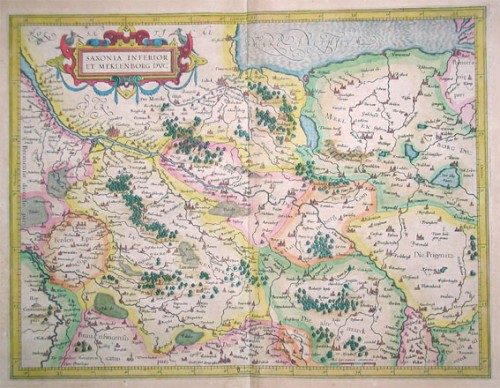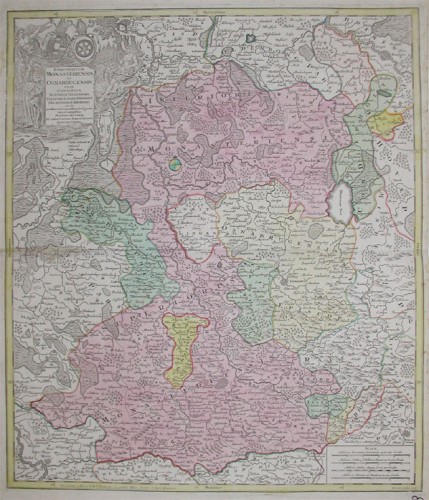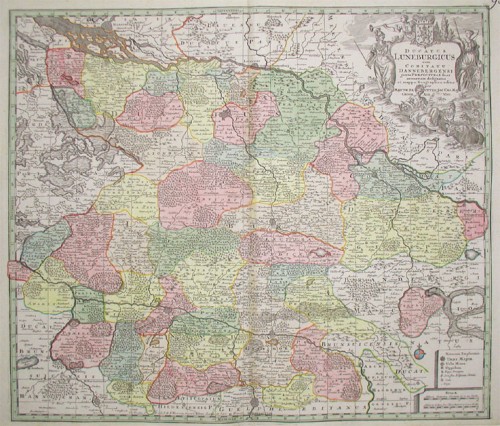Homann, J.B. (Homann Heirs)
Hildesheim Erzbistum
Episcopatus Hildesiensis Nec Non Vicinorum Statuum Delineatio Geographica. per Gerhard. Iust. Arenholdum Hildesiensem Iur. et Math. Stud. opera Haered. Ioh. Baptist. Homanni S.C.M. Geographi Norimbergae cum Priv. Sac. Caes. ut & Reg. Maj. Pol.
Eigenschaften
- Published: Homann Heirs , Nürnberg
- Published date: 1730
- Technique: Copper engraving / Original color.
- Type: Antique Map, map
- Issue date: 1730-40
- Category: Hildesheim
- Size: 483 by 562mm (19 by 22 inches).
- Stock number: 20505
- Condition: In excellent condition. Published plano without a centre fold. 483 by 562mm (19 by 22 inches).
Article description
Article description
Original antique copper engraving, hand colored in outline and wash when published. Die Karte zeigt in ihrer Mitte das Erzbistum Hildesheim. Die Karte erstreckt sich von Nord-Hannover und Braunschweig nach Einbeck im südlichen Hundsrück. Eine sehr dekorative und detaillierte Karte dieser Region mit vielen Ortsnamen, Burgen, Klöstern, Bergen, Flüssen und Wäldern. Unten rechts ist ein Inset Plan von Hildesheim zusammen mit einem Panoramablick auf die Stadt Hildesheim. Die Titelkartusche in der unteren rechten Ecke ist mit allegorischen religiösen Attributen des Erzbistums Hildesheim graviert. The map shows in its centre the archbishopric of Hildesheim. The map extends from the Northern Hannover and Braunschweig towards Einbeck in the Southern Hundsrück. A highly decorative and detailed map of this region with many place names, castles, monasteries, mountains, rivers and woods. At the bottom we find an inset plan of Hildesheim together with a panoramic view of the city of Hildesheim. The title cartouche in the lower right corner is ornated with allegoric religious attributes to the archbishopric of Hildesheim. Johann Baptist Homann (20 March 1664 – 1 July 1724) was a German geographer and cartographer, who also made maps of the Americas. Homann was born in Oberkammlach near Kammlach in the Electorate of Bavaria. Although educated at a Jesuit school, and preparing for an ecclesiastical career, he eventually converted to Protestantism and from 1687 worked as a civil law notary in Nuremberg. He soon turned to engraving and cartography; in 1702 he founded his own publishing house. Homann acquired renown as a leading German cartographer, and in 1715 was appointed Imperial Geographer by Emperor Charles VI. Giving such privileges to individuals was an added right that the Holy Roman Emperor enjoyed. In the same year he was also named a member of the Prussian Academy of Sciences in Berlin. Of particular significance to cartography were the imperial printing privileges (Latin: privilegia impressoria). These protected for a time the authors in all scientific fields such as printers, copper engravers, map makers and publishers. They were also very important as a recommendation for potential customers. In 1716 Homann published his masterpiece Grosser Atlas ueber die ganze Welt (Grand Atlas of all the World). Numerous maps were drawn up in cooperation with the engraver Christoph Weigel the Elder, who also published Siebmachers Wappenbuch. Homann died in Nuremberg in 1724. He was succeeded by his son Johann Christoph (1703-1730). The company carried on upon his death as Homann heirs company, managed by Johann Michael Franz and Johann Georg Ebersberger. After subsequent changes in management the company folded in 1852.[1] The company was known as "Homann Erben", "Homanniani Heredes", or "Heritiers de Homann" abroad. (Wikipedia)Episcopatus Hildesiensis Nec Non Vicinorum Statuum Delineatio Geographica. per Gerhard. Iust. Arenholdum Hildesiensem Iur. et Math. Stud. opera Haered. Ioh. Baptist. Homanni S.C.M. Geographi Norimbergae cum Priv. Sac. Caes. ut & Reg. Maj. Pol.
Recently viewed products






